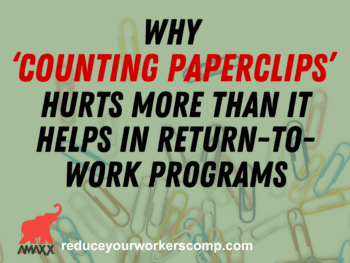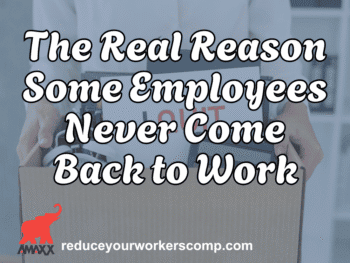
Return to Work Philosophies
There are two different philosophies regarding returning to work within a workers’ compensation program. Regardless of the philosophy, it is vital to keep injured employees engaged in the workplace and ensure they feel valued.
- Traditional Approach: Under this philosophy, the employer assigns job duties based on a review of job descriptions, reviewing medical records regarding the employee’s restrictions, and finding a job appropriate for the employee. This approach is very rigid.
- Collaborative Approach: This approach involves communication with all interested stakeholders – employees, supervisors, and medical providers. This approach allows everyone to “think outside the box” and be more creative.
Return to work that requires effort and energy can create opportunities for everyone. Under the traditional approach, employees sit at a desk and push papers. The employee becomes bored and develops negative feelings. Now is the time for you – the stakeholder – to decide if you want the process to be effective. Consider a collaborative approach to return to work.
Click Link to Access Free PDF Download
“13 Research Studies to Prove Value of Return-to-Work Program & Gain Stakeholder Buy-In”
Steps to Effective Return to Work
Return to work starts once the employee sustains a work injury, is stabilized, and the injury is reported correctly. Once these immediate steps occur, anyone interested in reducing workers’ compensation program costs should start thinking about getting the employee back to work.
- Assess the employee’s ability to work: This includes the need for future medical care and treatment and reasonable restrictions on activity. This requires effort to connect the employee and their medical providers.
- Assess the needs of their current position with the ability to work: Communication with the employee’s supervisor is required to understand the position better. Provide this information to the employee’s treating doctor. This can include a video of the employee performing the job or someone else, if not possible. Provide specifics as the job duties – time spent on feet, movements, distances, and weights of objects.
- Create an action place to return the employee to work: This can include timelines on medical care. It is also crucial for steps to prevent deconditioning. Ensure the employee receives physical and occupational therapy if necessary. Flexibility is vital.
The best result is if the employee can return to work in their usual position. Often this is not the case. Keeping the employee in the workplace in some capacity will avoid deconditioning, improve morale, and reduce money spent on the claim. It is essential to be progressive in steps taken and gradually increase the employee’s activity and return the employee to work over a period of time.
Calculate the Cost Savings of Return to Work
It is essential to monitor a return-to-work program and quantify the savings it makes in your program. When done correctly, this will allow for changes and determine if it is effective. Objectively demonstrating actual savings will promote buy-in from others.
The cost of any savings in return to work program is based on the number of work days “saved.” Metrics that need to be tracked include:
- Days “saved” by returning an employee to work; and
- Estimated “cost” of indemnity benefits saved per day.
Multiplying these two variables will result in the “savings” of a return to work program. This can be compared to a similar analysis when looking at the cost of replacing an employee or terminating their employment as part of a global claim settlement.
Employers interested in driving down workers’ compensation costs can create a Return To Work Coordinator responsible for some of these data-driven functions.
FREE DOWNLOAD: “13 Research Studies to Prove Value of Return-to-Work Program & Gain Stakeholder Buy-In”
Conclusions
Return to work should be a crucial part of every workers’ compensation program and something that starts following the injury. Remember the importance of including the injured employee in the process so they feel empowered and are interested in their claim’s direction. Necessary steps should also include following the essential steps and using objective calculations to quantify the success of what is being done. Now is the time to consider these items to reduce workers’ compensation costs.

Contact: mstack@reduceyourworkerscomp.com.
Workers’ Comp Roundup Blog: http://blog.reduceyourworkerscomp.com/
©2022 Amaxx LLC. All rights reserved under International Copyright Law.
Do not use this information without independent verification. All state laws vary. You should consult with your insurance broker, attorney, or qualified professional.

















